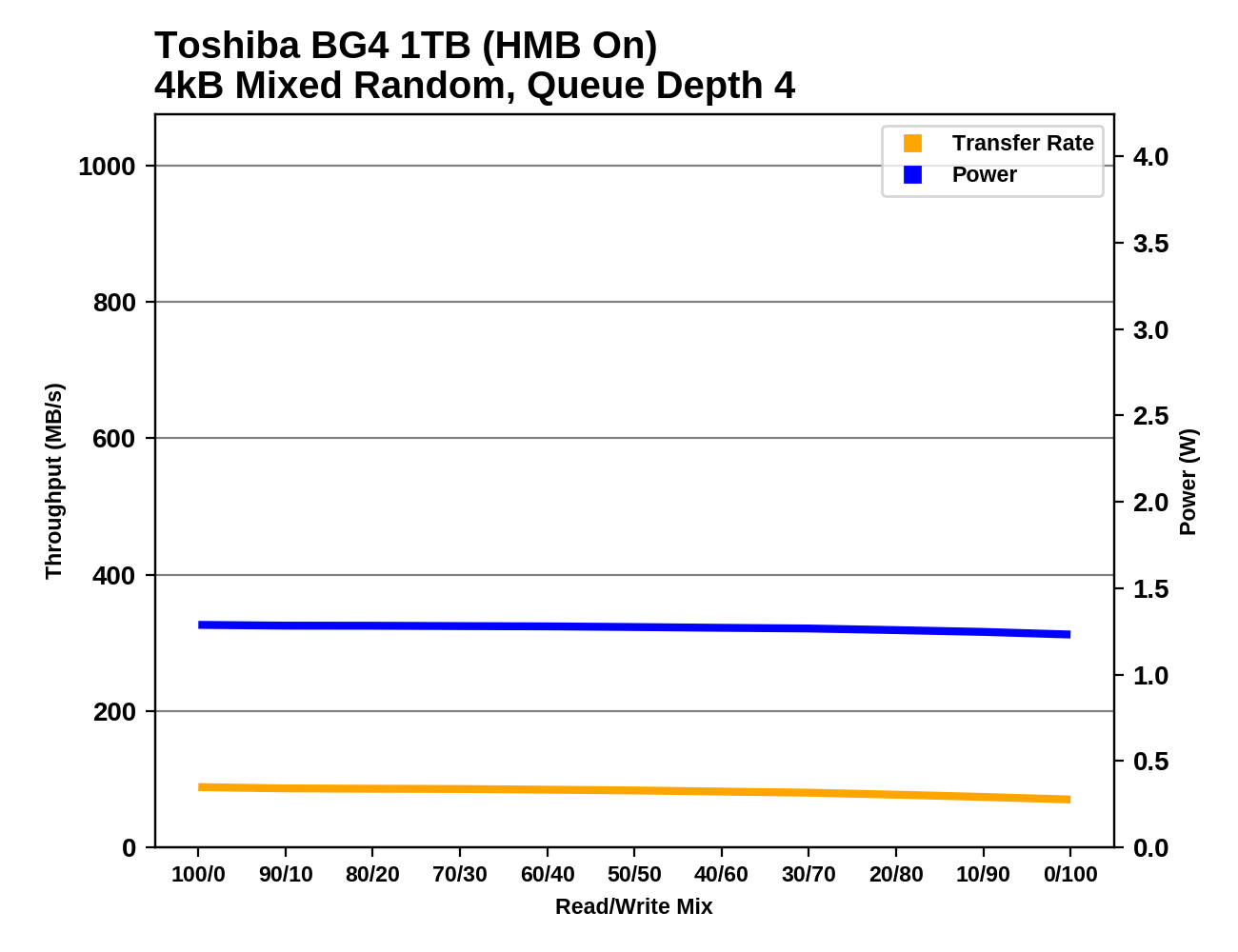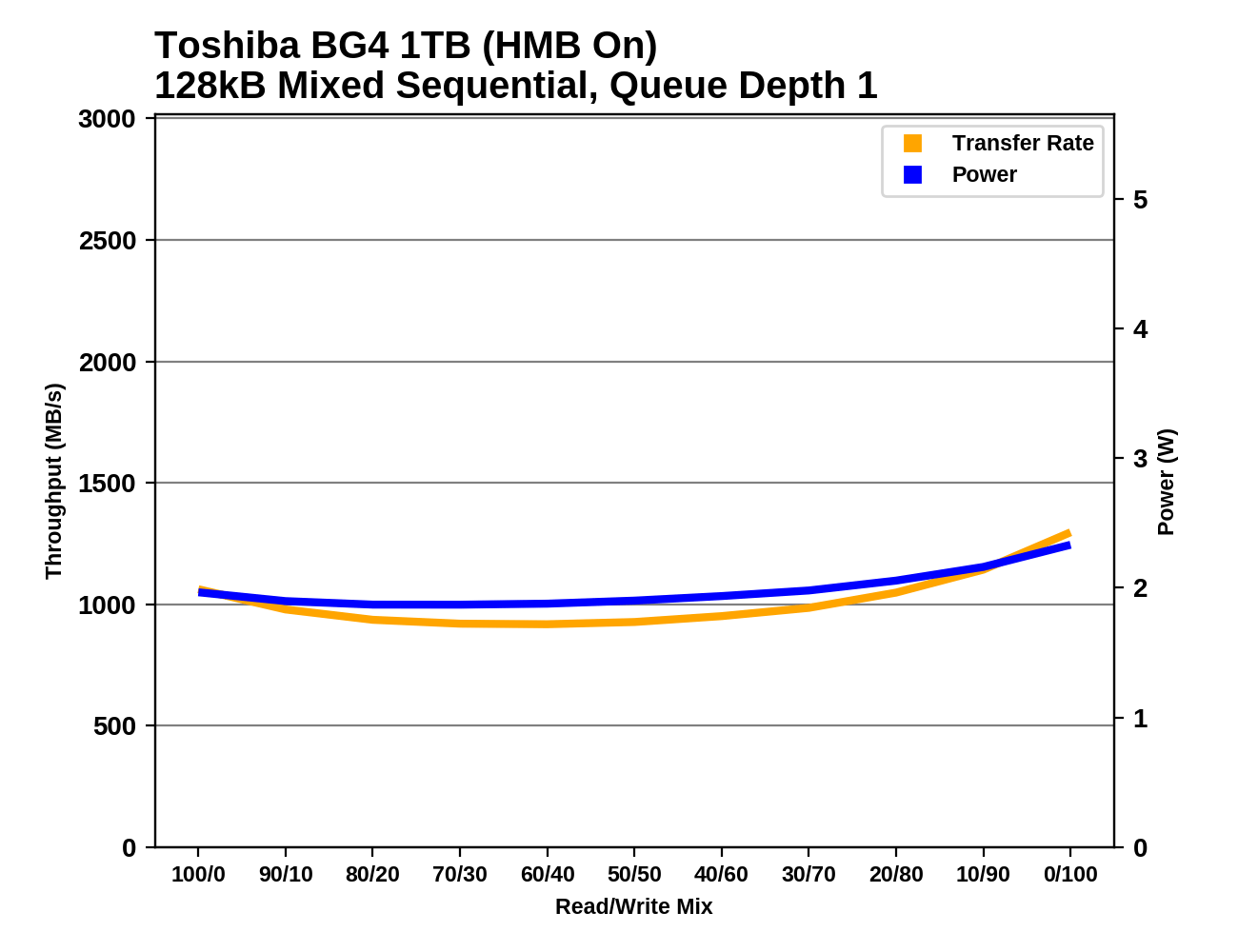The Toshiba/Kioxia BG4 1TB SSD Review: A Look At Your Next Laptop's SSD
by Billy Tallis on October 18, 2019 11:30 AM ESTMixed Random Performance
Our test of mixed random reads and writes covers mixes varying from pure reads to pure writes at 10% increments. Each mix is tested for up to 1 minute or 32GB of data transferred. The test is conducted with a queue depth of 4, and is limited to a 64GB span of the drive. In between each mix, the drive is given idle time of up to one minute so that the overall duty cycle is 50%.

This mixed random IO test covers a fairly wide span of the drive, so it's not a surprise to see that the Toshiba/Kioxia BG4 and other DRAMless SSDs end up being among the slowest drives overall, with HMB providing little or no help.
 |
|||||||||
| Power Efficiency in MB/s/W | Average Power in W | ||||||||
The power consumption of the BG4 during this test is as low as any other drive, but the limited performance means its efficiency score is still clearly worse than most of the drives that have their own DRAM.
 |
|||||||||
The performance of the BG4 is low and relatively flat across this test, declining slightly as the workload gets more write-heavy when most drives gain performance. With a working set small enough for the BG4's HMB configuration to be useful, we would likely see a very different performance profile.
Mixed Sequential Performance
Our test of mixed sequential reads and writes differs from the mixed random I/O test by performing 128kB sequential accesses rather than 4kB accesses at random locations, and the sequential test is conducted at queue depth 1. The range of mixes tested is the same, and the timing and limits on data transfers are also the same as above.

The BG4 is a bit more competitive on the mixed sequential IO test, almost matching the XG6's overall performance and more or less tied for fastest among the entry-level NVMe drives.
 |
|||||||||
| Power Efficiency in MB/s/W | Average Power in W | ||||||||
The BG4 comes out on top of the power efficiency rankings, with the WD Black SN750 a close second. Even with the lower performance of running without HMB, the BG4 stays near the top of the efficiency chart.
 |
|||||||||
Without HMB, the BG4's performance across the mixed sequential IO test is mostly flat, with a bit of an overall decline as the workload becomes more write-heavy. Enabling HMB allows the BG4 to pick up some speed during the last third of the test, but it doesn't have a huge impact.










31 Comments
View All Comments
intelati - Friday, October 18, 2019 - link
That last image is absolutely ridiculous. You get good performing 1TB of SSD storage on a postage stand.Jesus H Christ.
MaxUserName - Friday, October 18, 2019 - link
No, BG4 have too poor performance:https://www.storagereview.com/toshiba_bg4_nvme_ssd...
Ratman6161 - Friday, October 18, 2019 - link
I took a quick look at your link but quit looking when I saw they were testing SQL Server as one of their tests and with 15,000 virtual users. Completely useless use case. Even if you are are a software developer running a local copy of SQL Server, you won't be testing 15K users. So its performance somewhat pales in comparison to many full size m.2 SSD's. There are trade-offs to every component and in a laptop, particularly a thin and light laptop, those trade-offs usually have to favor saving space and power efficiency. It accomplishes those two goals on its own plus the smaller size may enable a larger battery in some systems. so what if your 2 TB 970 Evo outperforms it. The people buying the systems where this would be used won't care. It seems pretty ideally suited to its target audience.Tams80 - Friday, October 18, 2019 - link
I second that being a silly review.This is, as the article here states multiple times, for space-constrained devices. The BG4 more than meets the needs of these. As a bonus to us as customers, it means manufacturers are less likely to solder down the SSDs, so we can actually replace/upgrade them.
0ldman79 - Wednesday, November 13, 2019 - link
We're looking at a review right now.It's not as fast as NVME but it's faster than SATA on most benchmarks.
It's a quarter size of most NVME drives.
svan1971 - Saturday, October 19, 2019 - link
Lord, learn how to spell stamp, amen.wenart - Sunday, October 20, 2019 - link
Does Jesus have a second name?Jambe - Thursday, October 24, 2019 - link
Hieronymus, obviously.ToTTenTranz - Friday, October 18, 2019 - link
The Smach-Z uses a 2230 M.2 NVMe slot.Just saying.
Kishoreshack - Friday, October 18, 2019 - link
Excellent reviewdeep dive into the ssd we will get in our laptops
I just hope these form factors become common
&
are adopted for every laptop